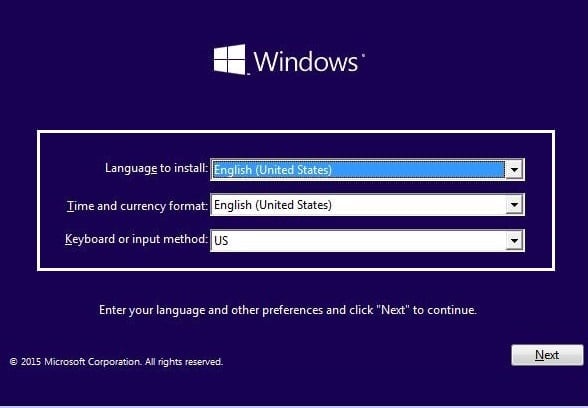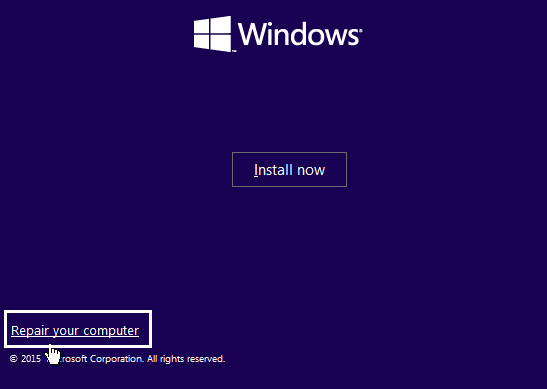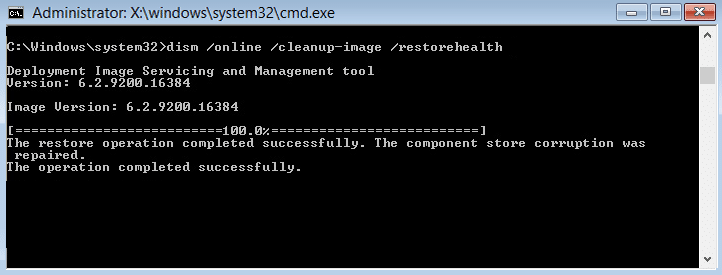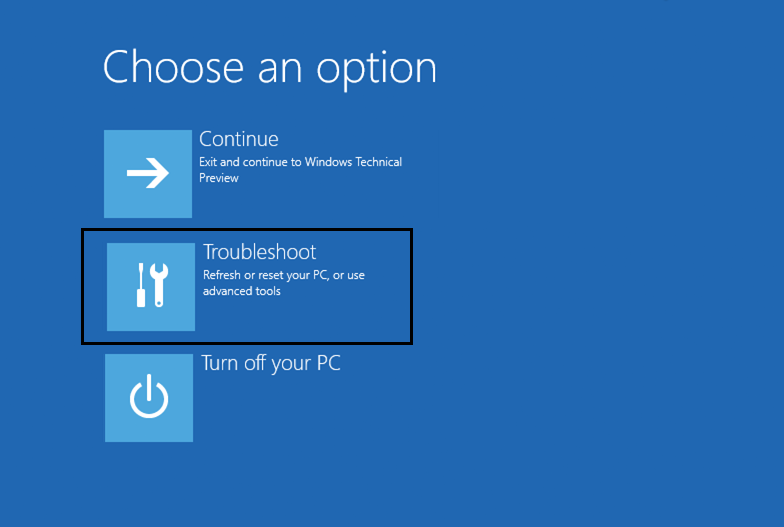Automatic repair is generally able to fix the boot failure error, this is a built-in option that comes along with Windows itself. When Windows 10 running system fails to boot, the Automatic Repair option tries to repair Windows automatically. In most cases, automatic repair fixes various issues related to boot failures but like any other program, it also has its limitations, and sometimes Automatic Repair fails to work. Automatic Repair fails because there are some errors or corrupted or missing files in your operating system installation that prevent Windows from starting correctly and if Automatic Repair fails then you won’t be able to get into Safe Mode. Often a failed automatic repair option will show you some kind of error message like this one: In a situation when Automatic Repair couldn’t repair your PC, Bootable installation media or Recovery Drive/System Repair Disc are helpful in such cases. Let’s get started and see step by step how you can fix Automatic Repair couldn’t repair your PC error. Note: For each and every step below you need to have Bootable installation media or Recovery Drive/System Repair Disc and if you don’t have one then create one. If you don’t want to download the entire OS from the website then you use your friend’s PC to create the disc using this link or you need to download official Windows 10 ISO but for that, you need to have a working internet connection and PC. IMPORTANT: Never convert a Basic disk that contains your operating system to a Dynamic disk, as it could make your system unbootable.
How to open Command Prompt at Boot in Windows 10
NOTE: You need to open Command Prompt at Boot a lot in order to fix various issues.
How to open Command Prompt at Boot in Windows 10 Fix Automatic Repair couldn’t repair your PC Method 1: Fix boot and rebuild BCD Method 2: Use Diskpart to fix corrupted file system Method 3: Use Check Disk Utility Method 4: Recover Windows registry Method 5: Repair Windows Image Method 6: Delete the problematic file Method 7: Disable Automatic Startup Repair Loop Method 8: Set correct values of device partition and osdevice partition Method 9: Disable driver signature enforcement Method 10: Last option is to perform Refresh or Reset
a) Put in the Windows installation media or Recovery Drive/System Repair Disc and select your language preferences, and click Next.
b) Click Repair your computer at the bottom.
c) Now choose Troubleshoot and then Advanced Options.
d) Select Command Prompt (With networking) from the list of options.
Fix Automatic Repair couldn’t repair your PC
Method 1: Fix boot and rebuild BCD
Open the Command prompt and type the following commands one by one & hit enter:
After completing each command successfully type exit.
Restart your PC to see if you boot to windows.
If you get an error in the above method then try this: bootsect /ntfs60 C: (replace the drive letter with your boot drive letter)
And again try the above commands which failed earlier.
Method 2: Use Diskpart to fix corrupted file system
Again go to Command Prompt and type: diskpart
Now type these commands in Diskpart: (don’t type DISKPART)
Now type the following command:
Restart to apply changes and see if you’re able to fix Automatic Repair couldn’t repair your PC error.
Method 3: Use Check Disk Utility
Go to command prompt and type the following: chkdsk /f /r C:
Now restart your PC to see if the problem is fixed or not.
Method 4: Recover Windows registry
Enter the installation or recovery media and boot from it.
Select your language preferences and click next.
After selecting language press Shift + F10 to command prompt.
Type the following command in the Command Prompt: cd C:\windows\system32\logfiles\srt\ (change your drive letter accordingly)
Now type this to open the file in notepad: SrtTrail.txt
Press CTRL + O then from file type select “All files” and navigate to C:\windows\system32 then right-click CMD and select Run as administrator.
Type the following command in cmd: cd C:\windows\system32\config
Rename Default, Software, SAM, System, and Security files to .bak to back up those files.
To do so type the following command: rename DEFAULT DEFAULT.bak rename SAM SAM.bak rename SECURITY SECURITY.bak rename SOFTWARE SOFTWARE.bak rename SYSTEM SYSTEM.bak
Now type the following command in cmd: copy c:\windows\system32\config\RegBack c:\windows\system32\config
Restart your PC to see if you can boot to Windows.
Method 5: Repair Windows Image
Open Command Prompt and enter the following command: DISM /Online /Cleanup-Image /RestoreHealth
Press enter to run the above command and wait for the process to complete, usually, it takes 15-20 minutes. NOTE: If the above command doesn’t work then try this: Dism /Image:C:\offline /Cleanup-Image /RestoreHealth /Source:c:\test\mount\windows or Dism /Online /Cleanup-Image /RestoreHealth /Source:c:\test\mount\windows /LimitAccess
After the process is completed restart your PC.
Reinstall all the windows drivers and fix Automatic Repair couldn’t repair your PC error.
Method 6: Delete the problematic file
Access Command Prompt again and enter the following command: cd C:\Windows\System32\LogFiles\Srt SrtTrail.txt
When the file opens you should see something like this: Boot critical file c:\windows\system32\drivers\tmel.sys is corrupt.
Delete the problematic file by entering the following command in cmd: cd c:\windows\system32\drivers del tmel.sys
NOTE: Don’t delete drivers which are essential for windows to load the operating system 4. Restart to see if the issue is fixed if not continue to the next method.
Method 7: Disable Automatic Startup Repair Loop
Open Command Prompt and enter the following command: NOTE: Only disable if you are in Automatic Startup Repair Loop bcdedit /set {default} recoveryenabled No
Restart and Automatic Startup Repair should be disabled.
If you need to again enable it, enter the following command in cmd: bcdedit /set {default} recoveryenabled Yes
Reboot to apply changes.
Method 8: Set correct values of device partition and osdevice partition
In Command Prompt type the following and press enter: bcdedit
Now find the values of device partition and osdevice partition and make sure their values are correct or set to correct partition.
By default value is C: because Windows comes pre-installed on this partition only.
If by any reason it is changed to any other drive then enter the following commands and press Enter after each one: bcdedit /set {default} device partition=c: bcdedit /set {default} osdevice partition=c:
Note: If you have installed your windows on any other drive make sure you use that one instead of C: 5. Reboot your PC to save changes and fix Automatic Repair couldn’t repair your PC error.
Method 9: Disable driver signature enforcement
Put in the Windows installation media or Recovery Drive/System Repair Disc and select your language preferences, and click Next.
Click Repair your computer at the bottom.
Now choose Troubleshoot and then Advanced Options.
Choose Startup Settings.
Restart your PC and press the number 7 (If 7 isn’t working then relaunch the process and try different numbers).
Method 10: Last option is to perform Refresh or Reset
Again insert Windows 10 ISO then select your language preferences and click Repair your computer at the bottom.
Choose Troubleshooting when the Boot menu appears.
Now choose between the option Refresh or Reset.
Follow the on-screen instructions to complete the Reset or Refresh.
Make sure you have the latest OS disc (preferably Windows 10) in order to complete this process. Recommended for you:
How to fix Server’s certificate has been revoked in chrome Fix ERR_TUNNEL_CONNECTION_FAILED error in Google Chrome Fix Error Code 0x80070002 The system cannot find the file specified How to fix Audio services not responding in Windows 10
By now you must have successfully fix Automatic Repair couldn’t repair your PC but if you still have any questions regarding this guide please feel free to ask them in the comment section.




























